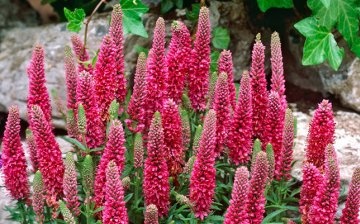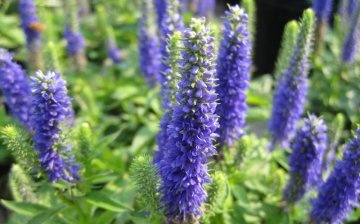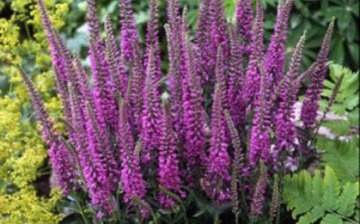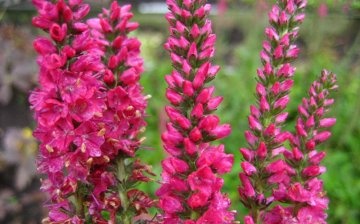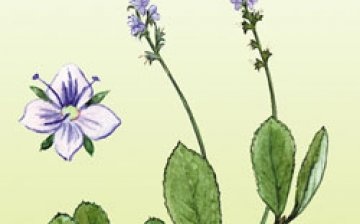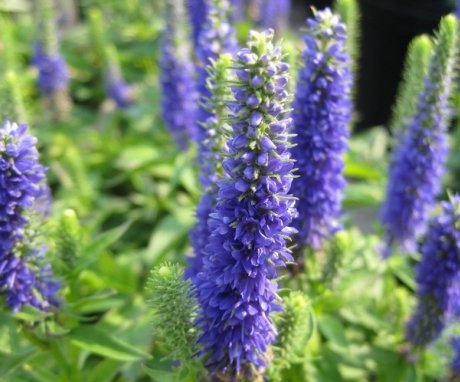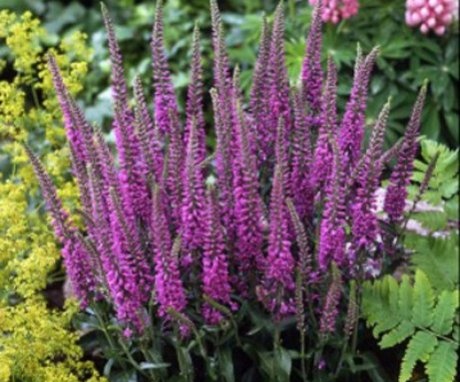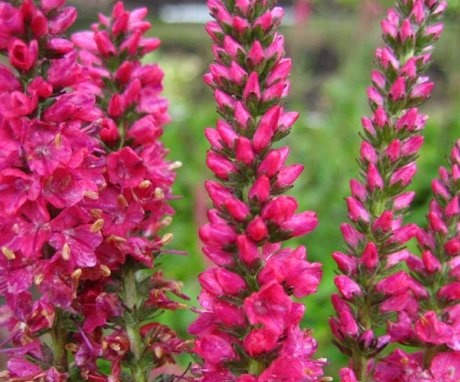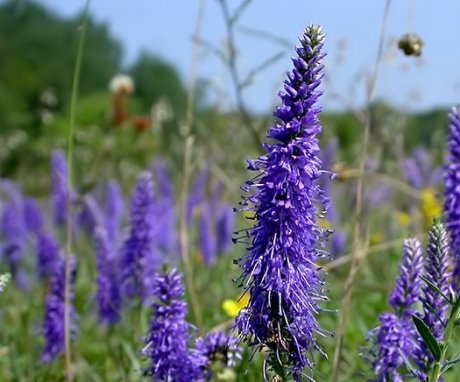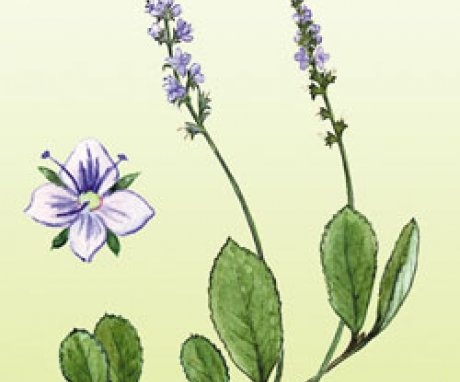Gentle Veronica in your garden
Veronica is a unique and diverse plant. With a more thorough study of its medicinal properties, you can practically not go to doctors for help and to pharmacies for medicines. And for lovers of gardening and floriculture, the variety of varieties and types of Veronica will allow them to decorate their plots with a unique combination. And if you choose the right varieties and plant them close to each other, then their flowering will delight and delight from early spring to late autumn.
Content:
- General information about the plant
- Types of Veroniiika
- Raising Veronica
- Useful properties and application of Veronica
General information about the plant
Veronica is a plant that belongs to the flowering genus.
Various varieties of this species can be found almost all over the world. A very unpretentious, drought-resistant plant, adapts to any climatic conditions. The soil is also varied for different varieties, from sandy and clayey to loose and marshy. It took a long time to get into ornamental gardens and flowerbeds; it grew more and more in the fields and in the mountains.
After Veronica was domesticated, the plant acquired many new varieties adapted for ornamental gardening.
This plant has been known since very ancient times, even then people understood that it is medicinal... It is not known where the name "Veronica" came from, or from the Greek - "small oak", or from the Latin "real medicine" or "genuine plant". Some believe that they named it in honor of Saint Veronica.
Types of Veronica
There are more than 300 species in the Veronica genus, however, not all are suitable for growing in the garden.
But those varieties that are suitable for ornamental cultivation do not bring a lot of hassle in the care and maintenance. Veronica is a very hardy, long-flowering plant and has various forms of growth. Let's list the most popular and flowering species.
Veronica officinalis:
- In nature, Veronica officinalis is very common; it can be found in Europe, North America, the Caucasus, Turkey and even Siberia.
- Grows in light sparse forests. Veronica officinalis in appearance resembles a Forget-me-not flower.
- It differs in that the stems of Veronica officinalis stretch out and intertwine with each other, forming a beautiful green rug with blue flowers.
- Looks very nice on flower beds and paths... The leaves of this variety are ovoid and slightly harsh, have a short stem.
- The flowers are pale blue, sometimes white.
- The flowering period extends over almost the entire summer.
- Propagated vegetatively and by seeds.
- You can sow Veronica officinalis before winter or spring.
- After planting, flowers appear only after 2 years.
- It can be planted in poor soils and shady places and has a very high survival rate even in dry weather.
Veronica long-leaved:
- This type of plant grows in humid places and marshy soils. It is often found in the Belarusian forests.
- It is considered one of the tallest varieties of this species, the stem height reaches 120 cm.The cluster of the inflorescence can be 20 cm long.
- The leaves have an ovoid shape, they are pointed at the edges, the petioles are short.
- On the stem it is located opposite each other or 3-4 leaves in whorls.
- The flowers of Veronica are long-leaved blue, collected in sparse brushes, which taper towards the end. Blooms from early summer to September.
- It bears fruit in the form of bolls, the ripening of which begins in August.
- Recently, several hybrids of this Veronica variety have been bred with larger white and blue flowers.
Veronica Crimean:
- It grows mainly in the Crimea, hence the name, on rocks in the highlands.
- The plant itself is undersized, its maximum height is about 30 cm.
- The leaves of a small plant have a bright green color, and the flowers are collected in small inflorescences in the form of brushes.
- The flower petals are pale blue with a white stamen.
- Such a flower is more suitable for a rock garden.
- It will bloom if planted in a well-lit open area, from May to mid-summer.
- Reproduction of this variety of Veronica happens with the help of seeds or vegetatively.
Veronica bushy:
- It grows in the countries of Northern Europe and in the mountains of Central and Southern Europe.
- Veronica grows bushy in the form of small shrubs up to 15 cm high.
- The leaves are oblong, shiny, wedge-shaped at the base, small.
- The base of the bush is woody, the stems are branched, the leaves are sparsely located on them.
- Small flowers are collected in small clusters. The color of the flower is blue, sometimes pink.
- The peduncle is very short, almost invisible.
- Veronica blooms bushy in June and July, and the fruits ripen by September.
- It is preferable to plant this plant in partial shade and on rocky terraces.
Veronica Steller:
- An oriental variety of this species is native to China and Japan.
- Plant height reaches 25 cm, and the top is crowned with an inflorescence.
- Stems are straight and pubescent. Leaves are ovate, toothed, up to 3 cm long.
- Inflorescences are spike-shaped and short, at the beginning of flowering the ear is dense, later it becomes looser.
- Veronica Stellera blooms in blue or purple.
- Blooms from July to autumn.
- Looks very nice on flower beds, especially with contrasting colors.
Veronica creeping:
- It is a plant that grows in the steppes, meadows and fields of Asia, Siberia and Central Europe.
- The creeping plant forms a dense carpet up to 10 cm high with bluish or blue flowers.
- The leaves are ovoid and have short legs.
- Bred varieties with pink flowers and white.
- The great advantage of this Veronica variety is that it stays green even in winter.
- Very suitable for rocky gardens and ornamental ponds.
- Veronica propagates by creeping seeds or cuttings.
- After planting the seeds, flowering occurs after 2 years of plant life. This plant is cut in May.
Veronica Dubravnaya:
- You can meet this plant on the territory of half of the continents: Asia, North America, Europe.
- Veronica Dubravnaya reaches a height of 45 cm.
- Its stems are pubescent and branched in the upper part.
- The lower part of the stems adheres to the soil and takes root over time.
- The leaves are rounded and pubescent like stems, serrated along the edges.
- It blooms in bright blue or purple, white inflorescences are very rare. Blooms very densely from late May to mid-summer.
- A very hardy plant, so it can be found in gardens and parks.
- It grows very well and looks great on lawns and flower beds.
- Propagated by shoots and rooted stems.
Veronica broadleaf:
- Veronica broadleaf grows almost throughout Russia, in Central Asia, Western Europe.
- The stem height can reach up to 70 cm, they are erect and stretch upwards.
- Leaves are ovoid and serrated at the edges.
- It has blue, pink and white flowers, which are collected in inflorescences in the form of brushes, their length is about 7 cm.
- It blooms from the end of May for 4.5 weeks.
- Plants that have been woven into bushes for several years, forming beautiful flowering caps.
- The plant is moisture-loving, but very hardy and drought-resistant.
- Propagated by dividing the rhizome.
- The seeds have a very poor germination capacity, so such reproduction is extremely rare.
- After planting, the plant throws out peduncles after a year.
Veronica spikelet:
- It grows in the territories of Western Europe, the Mediterranean, Central Asia and Siberia.
- The plant has single stems, which are about 40 cm high.
- The inflorescences are located at the top of the stem and are usually very dense and up to 10 cm long.
- Veronica spikelet blooms in blue, purple, white and pink, from mid-June to late July.
- Very unpretentious plant, drought-resistant.
- It can be planted in any loose soil in well-lit areas.
- It tolerates cold very well, but reacts poorly to waterlogging of the soil.
- The division of rhizomes, seeds and stem cuttings propagates.
- There are a large number of varieties bred specifically for decorative planting.
Raising Veronica
Almost all Veronica varieties prefer light or semi-shaded places.
Although the plant is very unpretentious, during the winter months the soil should not be waterlogged, as the flower may die. Plant care is very simple, almost any soil is suitable. An acceptable temperature is 14–20 degrees, however, many varieties easily tolerate dry periods of summer. Frequent watering is required in the spring, before the flowering period. And when the flowers have already blossomed, watering must be reduced. After the flowers have faded, the aerial part of the plant can be cut off, giving the opportunity to release new young leaves. Thus, the plant will look beautiful throughout the spring-summer period, and even in the fall.
Veronica reproduces in several ways:
- By dividing the rhizome.
- By cuttings.
- Seeds.
Each gardener chooses a method that is more convenient for him. For planting seeds in open ground, the favorable period is autumn. If seeds are planted in spring, then they must first be stratified. Cuttings are carried out in the summer. To do this, cut off the young tops of the stems. Then they can be rooted in the ground or put in water for sprouting roots. With good rooting, the plant can be planted in open soil.
The most popular way of breeding Veronica is by dividing the rhizome.
And with this method, it takes root faster and better in a new place. This process is best done in spring or early fall. Ground stems are cut and the plant is dug up. After that, you can divide the rhizomes with a knife or shovel. The division of the bush must be done evenly so that at least 3 shoots remain on each cut off root. And immediately after dividing, transplant to a new place or old but fertilized.
You can feed Veronica once every 2-3 years, because of her unpretentiousness and easy adaptation to almost any area, she will not cause a lot of trouble in this matter.
Useful properties and application of Veronica
Medicinal properties of Veronica have been known since ancient times and many ailments were treated with the help of this plant. In the modern world, it is used in its natural form only in traditional medicine.
The tops of plants with leaves and flowers have healing properties.
Collecting them begins in early summer, when flowering is just beginning and continues throughout the summer. The collection is dried very quickly, the temperature reaches 40 degrees. With this high temperature drying, flower loss is reduced and the natural color of the plant remains. The dried plant can be used only for 2 years, after the expiration of the period, the medicinal properties are lost. The composition of Veronica is very rich, it contains vitamins, essential oil, organic acids, carotene, glycosides and many others. useful material.
Veronica officinalis is used as an analgesic, healing, anti-inflammatory agent.
And the infusion of this herb improves appetite. In folk medicine, an infusion of Veronica officinalis is very often used.It is recommended to use it for abdominal pain, headache, colds, bronchial asthma. External use will help with eczema and fungal diseases.
More information can be found in the video.



